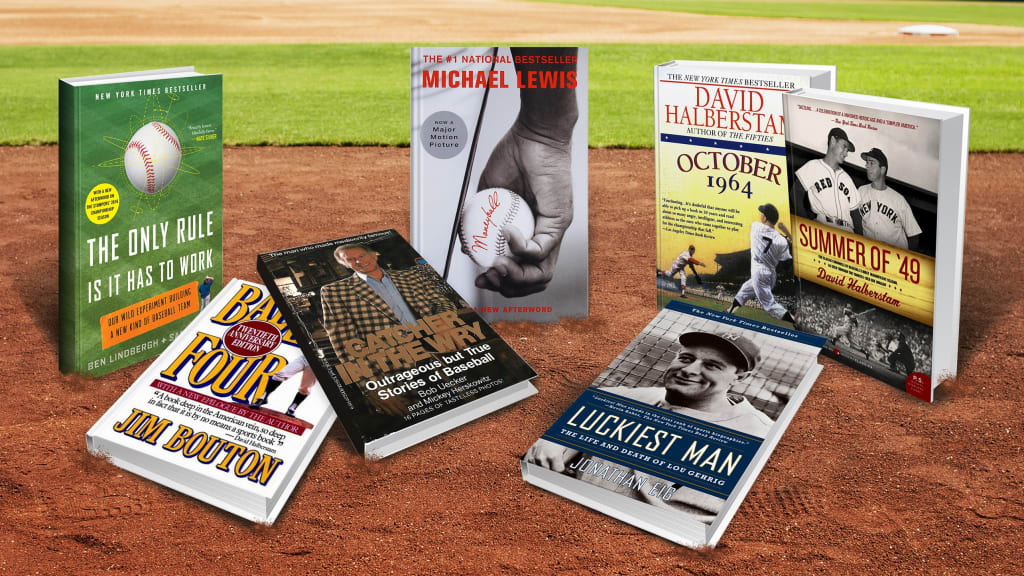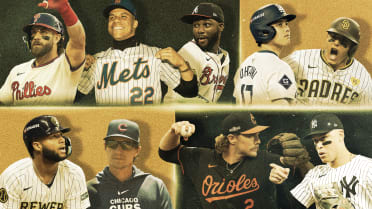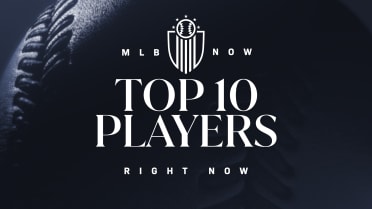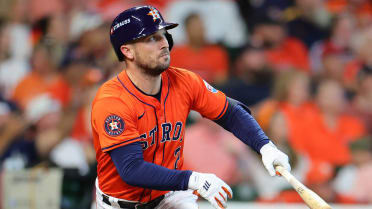Here's a list of our all-time favorite baseball books

In May 2020, we asked MLB.com reporters to name their favorite baseball book, and we broke them down in two sections below. Here is a look back at those picks.
The top section is for books that were picked by more than one reporter, and then a second section for books that got one vote each.
STAFF FAVORITES
"Catcher in the Wry" by Bob Uecker and Mickey Herskowitz
It takes one turn of the page to find a laugh in Bob Uecker’s autobiography. We’re talking pre-table of contents.
Here’s how Uecker begins the acknowledgements of the book he co-wrote with columnist Mickey Herskowitz, which was released in August 1982 while the Brewers were on the way to their only World Series to date: “When people ask who made me a broadcaster, or a baseball humorist, I give them the names of a dozen pitchers in the National League.” Thus begins a self-deprecating journey through Uecker’s life in baseball, from a .200-hitting backup catcher to a beloved broadcaster and entertainer known as “Mr. Baseball.”
The story is told many of the hilarious -- and occasionally true! -- yarns that Uecker spun on stage as an opening act for trumpeter Al Hirt. Those performances caught the attention of Johnny Carson and led to more than 100 appearances on "The Tonight Show." The rest is history. -- Adam McCalvy
"Summer of '49" by David Halberstam
"Summer of '49" presents the idea of baseball as a microcosm of society at the time. David Halberstam places the Yankees-Red Sox American League pennant race and the Joe DiMaggio-Ted Williams rivalry in the context of post-World War II America. Halberstam not only digs into the dichotomy between the grace of DiMaggio and the brusk, analytical approach of Williams, but he also delves into the difference between DiMaggio's public celebrity and private personality against the bright lights of New York, the difference in media coverage for each, a Red Sox club weighing expectations and disappointment and a Yankees team trying to overcome the idea that it’s a one-man band as DiMaggio deals all season with a nagging heel injury.
All of this plays out in a pennant race that goes to the final day of the regular season and a Yankees-Red Sox matchup in the Bronx, with a World Series berth and a batting title for Williams in the balance. You already know the ending, but how Halberstam brings you there is tremendous reading. -- Jason Beck
"The Only Rule Is It Has To Work" by Ben Lindbergh and Sam Miller
Baseball is at its best when it's innovating. Radical ideas have brought new life to the sport for a century-and-a-half. And yet, it's a lot easier to come up with those ideas than it is to implement them on an actual diamond with actual professional ballplayers.
Five years ago, Ben Lindbergh and Sam Miller were given the chance to run the Sonoma Stompers, an independent Minor League team in California. The two analytically inclined writers were free to implement any strategy they wanted to -- as long it worked. That premise makes the book a haven for open-minded baseball fans. (Five-man infields! Bullpen optimization!) But the challenges Lindbergh and Miller face offer a wonderful reminder of the complexities of the sport. Baseball has always been partially defined by its numbers. But as the authors make clear, it is, first and foremost, a game about people. -- AJ Cassavell
"Ball Four" by Jim Bouton with Leonard Shecter
Written by former big league pitcher Jim Bouton, this book stunned the sports world when it was released 50 years ago -- and it remains a must-read for any baseball fan. Though social media and the 24-hour news cycle have since changed the way fans interact with athletes, "Ball Four" provided a never-before-seen glimpse into the clubhouse and the lives of Major League Baseball players.
This irreverant diary of Bouton's 1969 season with the Seattle Pilots and Houston Astros pulled no punches, touching on everything from drinking and drug use among teammates (and himself) to contract disagreements between players and management at a time before free agency. Perhaps most controversial at the time was the way Bouton publicly shared stories about Mickey Mantle's drinking habits and off-field behavior. This first-of-its-kind look into the lives of some professional athletes has certainly stood the test of time. -- Paul Casella
"Luckiest Man: The Life and Death of Lou Gehrig" by Jonathan Eig
Many baseball fans -- and non-fans -- are familiar with Yankees great Lou Gehrig’s “luckiest man on the face of the Earth” speech in 1939, upon his retirement because of a then-unknown disease (ALS) that would eventually bear his name. Others might be familiar with the 1942 Gary Cooper movie, “Pride of the Yankees,” that romanticized Gehrig’s life with his team and his wife, Eleanor, and his once-record streak of 2,130 consecutive games played.
But what Jonathan Eig’s biography does -- in painfully vivid detail -- is describe what the two years were like after the Gehrig's speech as he sought direction for his life and a cure to his illness. In between trips to the Mayo Clinic, he worked as a probation officer, was often allowed to sit in the Yankees' dugout in street clothes and dealt with the day-to-day difficulties of a body betraying the man once lovingly known in baseball as "The Iron Horse." The book is also a full-life story about Gehrig’s younger years, his time with the Yankees, his relationship with Eleanor and his friendship with Babe Ruth. -- Mark Sheldon
"October 1964" by David Halberstam
Written almost as a bookend to “Summer of ’49,” “October 1964” is an excellent read about the last hurrah of the dominant-but-aging Yankees, a team that relied on established order and power. The upstart and modernizing Cardinals, in contrast, built a team on strategy and speed, and Halberstam examines the differences between these two teams while putting the 1964 season in a proper historical context.
It’s much more than a baseball analysis of the season. Halberstam illustrates how changes in American society, particularly around race and civil rights, were playing out in baseball. This book is a powerful look at the forces that transformed baseball in a pivotal time period by weaving in the life stories of players, managers, coaches, scouts and team owners. You get a detailed and humanizing portrait of the faces of baseball, like Mickey Mantle, Roger Maris, Bob Gibson and Lou Brock. You get your baseball fix through the buildup of the season and the drama of the seven-game World Series at the end. And you can start to understand the important intersection of baseball and society, shown through the end of an older era and the beginning of a new era. -- Anne Rogers
"Moneyball" by Michael Lewis
Years before legions of research-and-development staffers were hired around MLB to pore over TrackMan and Rapsodo tables and run complicated search-and-sort queries on mounds of data, conventional wisdom still largely prevailed in the decision-making of Major League front offices, thanks in large part to the well-established inertia of tradition in the game.
That’s the universe into which baseball outsider Michael Lewis, a finance and economics journalist, takes a deep dive in “Moneyball,” centered around the story of how Billy Beane, his staff and the financially limited Oakland A’s used contrarian thinking in player acquisition and evaluation in “The Art of Winning an Unfair Game,” as the title’s subhead declares. While the film adaptation took several liberties for Hollywood’s sake, the book itself weaves together the inner workings of baseball culture, recognizable names from around MLB and the dramatic story of the 2002 A’s and their legendary winning streak with a slightly more nuanced look at alternative ways of thinking about the game.
It’s a story that proved accessible and compelling for fans and outsiders alike -- and served as a first step to usher in a wave of people interested in thinking about baseball in a different way. -- Do-Hyoung Park
MORE GREAT READS
"The Arm" by Jeff Passan
As well as the writing is done and the story is laid out, the major draw is the gravity of the subject matter: the prevention of UCL tears is arguably the biggest mystery in baseball. Has anyone solved it, is that even possible and why did it take so long to attempt to slow the rise in cases? -- Jake Crouse
"Beyond the Sixth Game" by Peter Gammons
A fascinating, insightful and behind-the-scenes look at the colorful Red Sox teams of the mid 1970s, and the story behind their abrupt breakup in the early ‘80s. During that time period, no scribe was more plugged into the inner-workings of baseball -- and, in particular, the Red Sox -- than Peter Gammons. -- Ian Browne
"The Boys of Summer" by Roger Kahn
An all-time classic. Roger Kahn, who lived in the shadows of Ebbets Field, covered the Brooklyn Dodgers in the early 1950s for the New York Herald Tribune. The book covers Jackie Robinson breaking MLB’s color barrier, along with the tales of Pee Wee Reese, Carl Erskine and the rest, as well as the baseball bond Kahn shared with his father. -- Joe Frisaro
"Wait Till Next Year" by Doris Kearns Goodwin
This memoir, penned by one of our country's most celebrated historians, paints a vivid and heartwarming picture of what it was like to grow up as a Brooklyn Dodgers fan in the suburbs of New York in the 1950s, in a post-war era. Doris Kearns Goodwin fell in love with baseball at the age of 6, after scoring a game with her dad for the first time, and she's been hooked ever since. Who can't relate to that? -- Alyson Footer
"Veeck As In Wreck" by Bill Veeck with Ed Linn
One of the most eccentric figures in baseball history, Bill Veeck recounts much of his storied tenure as a team owner and executive, including the promotional stunts that made him famous. Veeck was ahead of his time in many ways, and his wit and unique sense of humor shine through this iconic memoir. -- Sarah Wexler
"Clemente: The Passion and Grace of Baseball's Last Hero" by David Maraniss
This brilliant biography by David Maraniss captures the spirit of Roberto Clemente, a baseball legend and humanitarian. The book is loaded with previously unknown information and details that would satisfy the most ardent Clemente enthusiasts and captivate casual baseball fans. -- Jesse Sanchez
"Late Innings: A Baseball Companion" by Roger Angell
In my early teen years, I drifted away from baseball and to football, but by college, I realized I’d turned my back on true love. This book reminded me of the personalities of the players, their attention to their craft, the often messy underbelly of labor and other situations -- and that a writer can remind you why you loved the sport unconditionally in the first place. -- Thomas Harding
"Baseball America’s UItimate Draft Book" by Allan Simpson
Allan Simpson founded Baseball America in part because he loved the Draft, and that love shines through this 766-page tome. Anything anyone could ever want to know about the Draft is in this book, including fascinating stories about superstars and players you’ve never heard of, annotated Draft lists jammed with fun facts and signing bonus information that’s not available anywhere else. You don’t even have to be a draftnik to enjoy it. -- Jim Callis
"If I Never Get Back" by Darryl Brock
This is a work of fiction about an emotionally battered man who steps off a train platform and mysteriously gets swept back in time to join up with the 1869 Cincinnati Red Stockings, the first professional baseball team. He plays for them, gets caught up with Mark Twain and tries to figure out what is going on in his life as the Reds travel west to San Francisco. -- T.R. Sullivan
"Ladies and Gentlemen, The Bronx is Burning" by Jonathan Mahler
The "Bronx Zoo" Yankees offer no shortage of storylines on their own, especially the dynamic clash of mega-egos featuring George Steinbrenner, Billy Martin and Reggie Jackson. But this work delves deeper and provides a vivid picture of New York City’s summer of 1977. Escalating crime, a maniac on the loose, racial tensions, a tense mayoral race and riots sparked by a blackout keep the drama at high levels as the Yankees fight toward the World Series title. -- Bryan Hoch
"Sandy Koufax, A Lefty’s Legacy" by Jane Leavy
Of all the Sandy Koufax bios, none captures the magnificence and mystery of the legend better than Jane Leavy’s 2002 bestseller. From his religion to his toughness and unselfishness, the book captures the Koufax known only by his teammates and friends, through interviews with dozens of them, with Koufax’s blessing. It’s not an autobiography, but Koufax spoke regularly with the author throughout the process. Hank Aaron said the book “is as good as Koufax.” -- Ken Gurnick
"The Summer Game" by Roger Angell
The first of several anthologies published by the esteemed fiction editor of The New Yorker magazine, this work demonstrates that writing well about baseball can be accomplished with elegance, emotion and introspection. Roger Angell speaks to the fan, capturing the beauty and the passion that make baseball the world’s greatest game. -- Chris Haft
"Weaver on Strategy" by Earl Weaver and Terry Pluto
Orioles manager Earl Weaver was a master at exploiting matchups and finding a way to get the most out of his roster. He was ahead of his time with his use of statistics, and some of the truisms in the book still hold today, such as his admonition against relying too much on Spring Training statistics or September performance when making player evaluations. The book opened my eyes to baseball strategy as a high-schooler, and I’ve been fascinated ever since. -- Steve Gilbert
"Eight Men Out" by Eliot Asinof
A vivid telling of the 1919 Black Sox and one of the most infamous cheating scandals in sports, one that -- a century later -- is still remembered among the mainstream and incredibly relevant. Beyond the intimate detail of the “fix,” this story delves into the player-owner relationship, the birth and role of the Commissioner and the lasting societal impact that the scandal left by the politics of it all. -- Daniel Kramer
"The Soul of Baseball" by Joe Posnanski
“Soul” is a word that can be applied equally to describe what made the late Buck O’Neil special and what makes Joe Posnanski’s writing special. When you combine the two in this journal of a season through O'Neil's eyes, you have a document that teaches the reader not simply the history of the Negro Leagues, but a lesson in class, character, calm and kindness. -- Anthony Castrovince
"The Bronx Zoo" by Sparky Lyle and Peter Golenbock
I read this book somewhere around the age of 13 and was intrigued by the behind-the-scenes look at baseball. Sparky Lyle and Peter Golenbock did a solid job of capturing life for the 1978 Yankees with a humorous edge in storytelling. -- Scott Merkin
"The Glory of Their Times" by Lawrence Ritter
Originally published in 1966, this book provides a rare primary-source perspective on baseball in the late 1800s and early 1900s. Lawrence Ritter interviewed more than 25 players from baseball’s early years who were still alive in the 1960s, getting first-person accounts from “heroes of a bygone era,” as he calls them in the preface. -- Sarah Langs
"The Bad Guys Won" by Jeff Pearlman
My 10th grade English teacher (hi, Mr. Queen) sent me to a writers' conference, and Jeff Pearlman was running a workshop on sportswriting. He gave me a copy of his book on the 1986 Mets and their escapades because I knew who Ed Hearn was. -- David Adler
"Leo Mazzone's Tales from the Mound" by Leo Mazzone and Scott Freeman
As the former Braves pitching coach, Leo Mazzone was involved in standout performances by future Hall of Famers in a dominating era. This book recounts the memorable outings and the knowledge he gained from his experiences, which I enjoyed discussing with him years later when I became a reporter. -- Jessica Camerato
"Five Seasons: A Baseball Companion" by Roger Angell
I have always enjoyed and admired Roger Angell’s literary style, the eloquent and lyrical way he describes the game. “Five Seasons” is the unofficial poet laureate of baseball at his best, spinning a narrative that glides us through the early-to-mid 1970s, perhaps the most significant half-decade in the history of the game. Angell writes about baseball like high art, which, of course, it often is. -- Joe Trezza
"Joe DiMaggio: The Hero’s Life" by Richard Ben Cramer
Few people have lived a more interesting life than Joe DiMaggio, and it turns out, I only knew a small part of his amazing story. From his upbringing in the Bay Area to his remarkable career with the Yankees to the end of his life, I became more fascinated than ever by "Joltin’ Joe." -- Brian McTaggart
"The Iowa Baseball Confederacy" by W.P. Kinsella
W.P. Kinsella’s more famous work is "Shoeless Joe" (better known to casual fans as “Field of Dreams”), but he also explored numerous themes (the impact of dreams and the role and influence of family, among other concepts) in this piece of fiction. In the novel, Gideon Clarke is consumed with proving that the 1908 Cubs played a game lasting thousands of innings against a small-town team from Iowa. A magical story unfolds from there. -- Jordan Bastian
"Playing America’s Game: Baseball, Latinos and the Color Line" by Adrian Burgos
This is a thorough examination of Latino participation in organized baseball before and after Jackie Robinson broke the color line in 1947. A gifted historian, Adrian Burgos shows how Latinos blurred the line between inclusion and exclusion during baseball’s segregated era and were used by team and league officials to manipulate racial policies, altering the terms of who gained access to the Major Leagues and when. -- Maria Guardado



